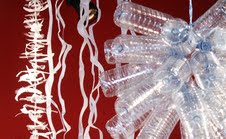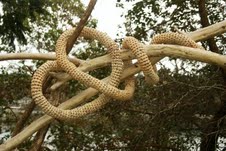
According to the Environmental Protection Agency, Americans produce more garbage than any people on Earth – more than 250 million tons of municipal solid waste per year, or 4.6 lbs. per person per day. Add to that the hundreds of millions of tons of refuse generated by American industry, and the specter of our national waste problem becomes nearly overwhelming.
Shelton-based artist Barbara De Pirro has found a way not only to reclaim and re-imagine cast-off material, but to elevate it into art – oftentimes, the kind of vibrant and stunningly original art sought after by gallery and museum curators. Certainly, making art from recyclable materials is not a new idea. But De Pirro began exploring the possibilities back in the early 1980’s – long before others picked up the thread. Her early work included assemblages and vessels made from found objects, and furniture that she deconstructed then reconfigured for new use. Today, her work is conceived less for function than for contemplation: when, for instance, elegant “biomorphic” spheres are crocheted from discarded plastic bags then grafted like clusters of buds onto huge, living trees, to unsettling effect.

The result: a kind of gorgeous détente between human beings and nature.
Building organic forms “presents a huge challenge when creating with these unnatural materials,” she says. For one observer at least, seeing synthetic buds “growing” along the trunk of a wild tree, or a crocheted “snake” similarly nestled among branches, has a cathartic effect: Perhaps waste may be put to high aesthetic purpose, after all.

For Spaceworks Tacoma, De Pirro is creating a literal universe from her vast cache of materials. Opening Oct. 9 at 912 Broadway, vortex plastica is a multi-dimensional installation featuring “a web-like form, a spun nest, a whirling tornado and a solar system filling the void, cross-lacing the [exhibit] space.” “My intent isn’t to create an installation of piles of plastic garbage, but to create forms that draw people in visually then rattle them a bit when they see that it is all created out of discarded plastics,” she explains.
The inspiration behind the piece is a dire one: the North Pacific Gyre, one of the world’s largest ecosystems, is also host to a trash vortex the size of Australia (commonly known as the “Pacific garbage patch,” it has been brought to public attention by Al Gore and scientists). Locked in a circular pattern of oceanic currents, the gyre’s huge, floating island of man-made debris, mostly plastics, is an environmental catastrophe for marine and bird as well as human life.

Discarded plastics are much more abundant now than earlier in her career, says De Pirro. “Most of my materials come from friends and family; they have been saving things for me for years. Plus, when doing an installation, I gather from the local community, pulling them into the process as well.” (The Habitat for Humanity Re-Store is a favorite.) She even recycles her own work, salvaging finished installations for raw material. Unfortunately, the glut of low-cost fodder is no cause for celebration: “There is an endless source that needs to be reused.” vortex plastica, 912 Broadway, Oct. 9, 2010 – Jan. 5, 2011. www.depirro.com
Barbara, You never fail to amaze me at your emense talent, and your hard work and dedication!!! I am so happy that you are receiving the exposure and recognition you deserve!
Keep Well and Happy,
Patty
Bravo – you have been busy.
You remind me that inspiration can “happen” anywhere.
bj